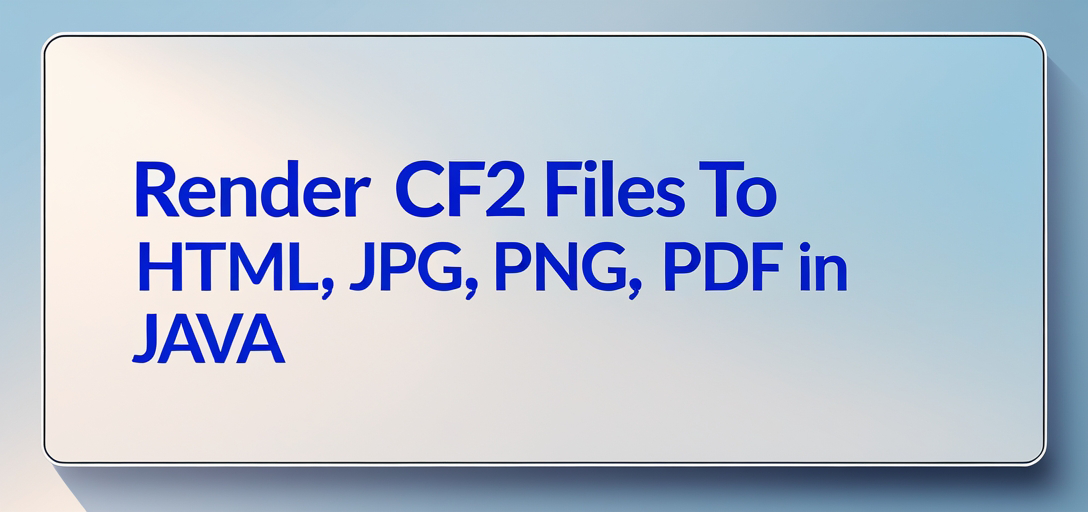Comprehensive Guide: Rendering CF2 Files to Various Formats Using GroupDocs.Viewer in Java
Introduction
Converting complex CAD files like CF2 into accessible formats such as HTML, JPG, PNG, or PDF can be challenging. This guide will show you how to use GroupDocs.Viewer for Java to render CF2 files—commonly used in 3D modeling—into various output formats effortlessly. By the end of this tutorial, you’ll know how to transform CAD drawings into user-friendly documents.

What You’ll Learn:
- Rendering CF2 files to HTML, JPG, PNG, and PDF using GroupDocs.Viewer for Java.
- Setting up your development environment for GroupDocs.Viewer.
- Understanding key configurations and customization options.
- Troubleshooting common issues during file conversion.
Let’s explore the prerequisites you’ll need!
Prerequisites
Before rendering CF2 files, ensure you have the following:
Required Libraries: Include GroupDocs.Viewer in your project using Maven for easy integration.
Environment Setup Requirements: Install Java Development Kit (JDK) and use an IDE like IntelliJ IDEA or Eclipse.
Knowledge Prerequisites: Basic understanding of Java programming, familiarity with IDEs, and experience working with file I/O in Java.
Setting Up GroupDocs.Viewer for Java
To start using GroupDocs.Viewer for Java, add the necessary dependencies to your project. Maven simplifies managing library versions:
Maven Setup
Add this configuration to your pom.xml:
<repositories>
<repository>
<id>repository.groupdocs.com</id>
<name>GroupDocs Repository</name>
<url>https://releases.groupdocs.com/viewer/java/</url>
</repository>
</dependencies>
<dependency>
<groupId>com.groupdocs</groupId>
<artifactId>groupdocs-viewer</artifactId>
<version>25.2</version>
</dependency>
License Acquisition
Start with a free trial from the official site for GroupDocs.Viewer, and consider purchasing a license for unlimited usage.
Basic Initialization and Setup
With your environment ready, initialize GroupDocs.Viewer:
import com.groupdocs.viewer.Viewer;
// Initialize viewer with file path or stream
Viewer viewer = new Viewer("path/to/your/document.cf2");
Now let’s delve into rendering CF2 files to various formats.
Implementation Guide
We’ll break down the implementation into four main features: converting CF2 files to HTML, JPG, PNG, and PDF. Each section includes step-by-step guidance with code snippets.
Rendering CF2 to HTML
Overview: Convert a CF2 file into an interactive HTML document with embedded resources.
Step 1: Import Required Packages
import com.groupdocs.viewer.Viewer;
import com.groupdocs.viewer.options.HtmlViewOptions;
import java.nio.file.Path;
import java.nio.file.Paths;
Step 2: Define Paths and Initialize Viewer
Set directory paths for your CF2 document and output HTML file.
Path inputDirectory = Paths.get("YOUR_DOCUMENT_DIRECTORY");
Path outputDirectory = Paths.get("YOUR_OUTPUT_DIRECTORY");
Path pageFilePathFormat = outputDirectory.resolve("CF2_result.html");
try (Viewer viewer = new Viewer(inputDirectory.resolve("Sample.cf2"))) {
HtmlViewOptions options = HtmlViewOptions.forEmbeddedResources(pageFilePathFormat);
viewer.view(options);
}
Explanation: This snippet initializes the Viewer with a CF2 file and specifies HTML view options to embed resources within the output.
Rendering CF2 to JPG
Overview: Convert your CF2 document into a JPEG image for easy sharing and viewing.
Step 1: Import Required Packages
import com.groupdocs.viewer.Viewer;
import com.groupdocs.viewer.options.JpgViewOptions;
Step 2: Initialize Viewer and Configure Options
Set up the output path for the JPG file and render the document.
Path pageFilePathFormat = outputDirectory.resolve("CF2_result.jpg");
try (Viewer viewer = new Viewer(inputDirectory.resolve("Sample.cf2"))) {
JpgViewOptions options = new JpgViewOptions(pageFilePathFormat);
viewer.view(options);
}
Explanation: The JpgViewOptions class specifies the output file path and renders the CF2 document as a JPEG image.
Rendering CF2 to PNG
Overview: Convert CF2 files into high-quality PNG images.
Step 1: Import Required Packages
import com.groupdocs.viewer.Viewer;
import com.groupdocs.viewer.options.PngViewOptions;
Step 2: Initialize Viewer and Configure Options
Define the output path for the PNG file and render it.
Path pageFilePathFormat = outputDirectory.resolve("CF2_result.png");
try (Viewer viewer = new Viewer(inputDirectory.resolve("Sample.cf2"))) {
PngViewOptions options = new PngViewOptions(pageFilePathFormat);
viewer.view(options);
}
Explanation: By using PngViewOptions, the CF2 file is rendered as a PNG image, ensuring high resolution and quality.
Rendering CF2 to PDF
Overview: Generate a PDF document from your CF2 file for easy distribution and printing.
Step 1: Import Required Packages
import com.groupdocs.viewer.Viewer;
import com.groupdocs.viewer.options.PdfViewOptions;
Step 2: Initialize Viewer and Configure Options
Set the output path for the PDF file and render it.
Path pageFilePathFormat = outputDirectory.resolve("CF2_result.pdf");
try (Viewer viewer = new Viewer(inputDirectory.resolve("Sample.cf2"))) {
PdfViewOptions options = new PdfViewOptions(pageFilePathFormat);
viewer.view(options);
}
Explanation: The PdfViewOptions class configures the rendering of CF2 files into PDF format, ensuring compatibility across devices.
Practical Applications
Rendering CF2 files with GroupDocs.Viewer for Java has numerous applications:
Architectural Presentations: Convert CAD drawings to HTML or PDF formats for client presentations.
Engineering Documentation: Share detailed designs as JPG or PNG images with team members.
Cross-Platform Compatibility: Make CF2 files accessible on devices without specialized software by converting them to universal formats.
Integration with Document Management Systems: Integrate rendering capabilities into workflows for automated conversion and archiving.
Online Viewing Platforms: Allow users to view CAD designs directly in web browsers using HTML output.
Performance Considerations
For optimal performance when using GroupDocs.Viewer:
- Configure viewer options tailored to specific needs to optimize resource usage.
- Dispose of
Viewerobjects promptly after use to manage memory efficiently. - Use caching if rendering multiple documents frequently to reduce processing time.
By following these best practices, you can enhance the efficiency and responsiveness of your document rendering processes.
Conclusion
In this guide, we explored how to leverage GroupDocs.Viewer for Java to render CF2 files into HTML, JPG, PNG, and PDF formats. By following these steps, you’re now equipped to integrate robust file conversion capabilities into your applications.
Next Steps
- Experiment with different rendering options available in GroupDocs.Viewer.
- Explore additional features like watermarking and customizing output formats.
We encourage you to implement these solutions and explore further functionalities offered by GroupDocs.Viewer.
FAQ’s
1. Can I customize the output for better quality or size?
Yes, GroupDocs.Viewer offers various options to configure resolution, image quality, and resource embedding during rendering.
2. Does it support batch conversion of multiple CF2 files?
Yes, you can automate multi-file conversions by looping through files and applying rendering methods sequentially.
3. Is GroupDocs.Viewer free to use?
You can start with a free trial; full features require purchasing a license for unlimited use.
4. Can I embed the rendered HTML in my website?
Absolutely, the HTML output can be integrated into web pages for online CAD viewing.
5. What are the system requirements for using GroupDocs.Viewer?
A compatible Java environment (JDK 8 or higher) and sufficient memory are recommended for smooth operation.